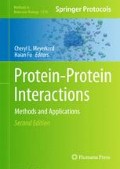Abstract
Nuclear magnetic resonance (NMR) has continued to evolve as a powerful method, with an increase in the number of pulse sequences and techniques available to study protein-protein interactions. In this chapter, a straightforward method to map a protein–protein interface and design a structural model is described, using chemical shift perturbation, paramagnetic relaxation enhancement, and data-driven docking.
Access this chapter
Tax calculation will be finalised at checkout
Purchases are for personal use only
References
Akke M (2002) NMR methods for characterizing microsecond to millisecond dynamics in recognition and catalysis. Curr Opin Struct Biol 12:642–647
Clore G, Gronenborn A (1991) Two-, three-, and four-dimensional NMR methods for obtaining larger and more precise three-dimensional structures of proteins in solution. Annu Rev Biophys Biophys Chem 20:29–63
Kay LE (1997) NMR methods for the study of protein structure and dynamics. Biochem Cell Biol 75:1–15
Vinogradova O, Qin J (2012) NMR as a unique tool in assessment and complex determination of weak protein–protein interactions. Top Curr Chem 326:35–45
O'Connell MR, Gamsjaeger R, Mackay JP (2009) The structural analysis of protein–protein interactions by NMR spectroscopy. Proteomics 9:5224–5232
Jensen MR, Ortega-Roldan JL, Salmon L et al (2011) Characterizing weak protein–protein complexes by NMR residual dipolar couplings. Eur Biophys J 40:1371–1381
Marintchev A, Frueh D, Wagner G (2007) NMR methods for studying protein–protein interactions involved in translation initiation. Methods Enzymol 430:283–331
Wittekind M, Mueller L (1993) Hncacb, a high-sensitivity 3d Nmr experiment to correlate amide-proton and nitrogen resonances with the alpha-carbon and beta-carbon resonances in proteins. J Magn Reson Ser B 101:201–205
Ikura M, Kay LE, Bax A (1990) A novel-approach for sequential assignment of H-1, C-13, and N-15 spectra of larger proteins – heteronuclear triple-resonance 3-dimensional Nmr-spectroscopy – application to calmodulin. Biochemistry 29:4659–4667
Grzesiek S, Bax A (1992) Correlating backbone amide and side-chain resonances in larger proteins by multiple relayed triple resonance NMR. J Am Chem Soc 114:6291–6293
Solomon I (1955) Relaxation processes in a system of two spins. Phys Rev 99:559–565
Jahnke W (2002) Spin labels as a tool to identify and characterize protein-ligand interactions by NMR spectroscopy. Chembiochem 3:167–173
Dominguez C, Boelens R, Bonvin AM (2003) HADDOCK: a protein–protein docking approach based on biochemical or biophysical information. J Am Chem Soc 125:1731–1737
Lyskov S, Gray JJ (2008) The RosettaDock server for local protein–protein docking. Nucleic Acids Res 36:W233–W238
Claussen H, Buning C, Rarey M et al (2001) FlexE: efficient molecular docking considering protein structure variations. J Mol Biol 308:377–395
Tovchigrechko A, Vakser IA (2006) GRAMM-X public web server for protein–protein docking. Nucleic Acids Res 34:W310–W314
Pierce BG, Hourai Y, Weng Z (2011) Accelerating protein docking in ZDOCK using an advanced 3D convolution library. PLoS One 6:e24657
Morris GM, Huey R, Lindstrom W et al (2009) AutoDock4 and AutoDockTools4: automated docking with selective receptor flexibility. J Comput Chem 30:2785–2791
Beck MR, Otey CA, Campbell SL (2011) Structural characterization of the interactions between palladin and alpha-actinin. J Mol Biol 413:712–725
Joseph C, Stier G, O'Brien R et al (2001) A structural characterization of the interactions between titin Z-repeats and the alpha-actinin C-terminal domain. Biochemistry 40:4957–4965
Bodenhausen G, Ruben DJ (1980) Natural abundance N-15 Nmr by enhanced heteronuclear spectroscopy. Chem Phys Lett 69:185–189
Delaglio F, Grzesiek S, Vuister GW et al (1995) NMRPipe: a multidimensional spectral processing system based on UNIX pipes. J Biomol NMR 6:277–293
Hubbard SJ, Thornton JM (1993) NACCESS Computer Program, Department of Biochemistry and Molecular Biology, University College London www.bionf.manchester.ac.uk/naccess/nac_intro.html
de Vries SJ, van Dijk M, Bonvin AM (2010) The HADDOCK web server for data-driven biomolecular docking. Nat Protoc 5:883–897
Venters RA, Calderone TL, Spicer LD et al (1991) Uniform 13C isotope labeling of proteins with sodium acetate for NMR studies: application to human carbonic anhydrase II. Biochemistry 30:4491–4494
Kuipers BJ, Gruppen H (2007) Prediction of molar extinction coefficients of proteins and peptides using UV absorption of the constituent amino acids at 214 nm to enable quantitative reverse phase high-performance liquid chromatography-mass spectrometry analysis. J Agric Food Chem 55:5445–5451
Mulder FA, Schipper D, Bott R et al (1999) Altered flexibility in the substrate-binding site of related native and engineered high-alkaline Bacillus subtilisins. J Mol Biol 292:111–123
DeLano WL (2006) MacPyMOL: The PyMOL Molecular Graphics System, Version 1.5.0.4 Schrödinger, LLC www.pymol.org
Author information
Authors and Affiliations
Corresponding author
Editor information
Editors and Affiliations
Rights and permissions
Copyright information
© 2015 Springer Science+Business Media New York
About this protocol
Cite this protocol
Thompson, P.M., Beck, M.R., Campbell, S.L. (2015). Protein-Protein Interaction Analysis by Nuclear Magnetic Resonance Spectroscopy. In: Meyerkord, C., Fu, H. (eds) Protein-Protein Interactions. Methods in Molecular Biology, vol 1278. Humana Press, New York, NY. https://doi.org/10.1007/978-1-4939-2425-7_16
Download citation
DOI: https://doi.org/10.1007/978-1-4939-2425-7_16
Publisher Name: Humana Press, New York, NY
Print ISBN: 978-1-4939-2424-0
Online ISBN: 978-1-4939-2425-7
eBook Packages: Springer Protocols

